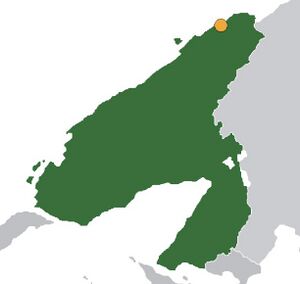1993 Saterocian nuclear test
| 1993 Saterocian nuclear test | |
|---|---|
 Map showing estimated location of the test | |
| Information | |
| Country | Sateroc |
| Test site | Crafere Nuclear Test Site, Cascutia |
| Date | May 20, 1993 |
| Period | 02:32:16 SLT |
| Number of tests | 1 |
| Test type | Unknown |
| Device type | Fission |
| Max. yield | Estimated at least 18 kilotons(75 TJ) |
| Test series chronology | |
The 1993 Saterocian nuclear test was the detonation of a nuclear device conducted by Sateroc on May 20, 1993.
Days before, on 12 May, Andre Puoc and the Saterocian government announced its intention to conduct a nuclear test. The blast is estimated to have had an explosive force of around 18 kilotons, however the actual number is unknown due to Sateroc's secretive nature. Radioactive output was detected following the blast in the Northern Ocean following the estimated time of the blast, as well as seismic activity in the general area.
Reportedly, a few embassies in Kolkesburg were given a 15-minute notice of the oncoming nuclear test, and these unnamed countries warned other governments, such as bigger nations and intergovernmental organizations, of the supposed nuclear test. Minutes before the test, it was announced that a Saterocian nuclear test was 'imminent', prompting other nations to prepare condemnations.
Background
By the 1970s, Sateroc was under the leadership of dictator Andre Puoc, who had become paranoid following the assassination of his father and former Saterocian dictator, Tilmann Puoc. Puoc blamed the assassination on Vœyetskan and Saroqi operatives operating in Kolkesburg against the dictatorship, however it was later found out that the perpetrator was a Cascutian nationalist as part of the War in Cascutia. However, these strong accusations caused tensions to mount between Sateroc and its neighbors, kickstarting the Vasilin Sea crisis.
Vasilin Sea crisis
The Vasilin Sea crisis was a period of heightened tensions between Sateroc and multiple countries in the Vasilin Sea, starting after Sateroc's first invasion of Sateroc and ending after the 2019 Saterocian Revolution. The crisis was also heavily tied with the War in Cascutia, a low-intensity asymmetrical conflict in the region of Cascutia between Cascutian militias and the Saterocian government. Starting in the late 80s, both of these conflicts began to rapidly escalate after aggressive moves by Puoc, who was seeking to "dominate" Sateroc's neighbors politically, militarily, and economically after he began "reclamation efforts" in the Vasilin Sea. This led to the Saterocian Navy making moves in the Vasilin Sea, going out into international waters, and sometimes even nearing national waters of other countries which were at odds with Sateroc.
During the 1990s, both sides of the crisis were preparing for a potential military conflict, as it was a time when both the Saterocian and Vœyetskan navies were sinking ships and even some naval vessels, which prompted international condemnation against Sateroc. Puoc, which had grown extremely paranoid by this point, feared of a potential western invasion of Sateroc, which of course never came, however forced the regime to rethink its strategy.
Saterocian nuclear program
By the mid-1980s, it was clear that Sateroc was maintaining a clandestine nuclear weapons program, due to the completed construction of various nuclear reactors across concealed and undisclosed locations in Cascutia. However, almost no diplomatic means were used by the international community to limit Sateroc's nuclear weapons program due to Puoc's general stubborness. Instead, international sanctions were placed on Sateroc, hoping to economically and diplomatically pressure Sateroc into cutting the program. Sateroc, which had become heavily self-reliant, continued work on the program, constructing more nuclear reactor locations and further developing scientific research. By 1990, rumors circulated that Sateroc was pursuing nuclear enrichment technology, and that same year Sateroc claimed that they had a "right" to possess nuclear weapons.
By this point, diplomatic agreements were proposed by other nations, however Sateroc refused to cooperate, drawing even more international condemnation. In 1992, a year before the nuclear test, Sateroc allowed scientists from around the world to inspect its plutonium production facilities in southern Cascutia, and some of these scientists claimed that Sateroc had already been able to produce a nuclear weapon, however others stated that although their research seemed to be going successfully, they had not been able to produce nuclear weapons of any kind yet. In 1995, a foreign senior scientist claimed that Sateroc's nuclear weapons program was much more advanced than originally anticipated in 1992 during the scientists' visit.
In late 1992, Sateroc claimed to have made "massive breakthroughs" in its nuclear weapons program, claiming that they had processed plutonium into a workable nuclear deterrent. frantic diplomatic attempts by international governments were made to reach an agreement concerning the Saterocian nuclear weapons program, however little achievements were made in making any sort of progress. Throughout the rest of 1992 and into 1993, the nature Sateroc's nuclear weapons program remained ambiguous due to the absence of any actual nuclear test. While while most, if not all scientist organizations had agreed that the Saterocian regime was capable of producing a nuclear weapon of mass destruction, there was little agreement in how powerful the weapon could be, with some claiming a potential yield of less than one kilotons, up to 25 kilotons in yield.
Threats made by Puoc
On May 9, Saterocian government officials claimed that it was capable of obliterating its enemies using its nuclear weapons arsenal. However, experts at this time agreed that these statements were "not credible" considering that they believed Sateroc's nuclear weapons program was less advanced than what others claimed it was.
Test
Test site
According to initial reports, experts believed that the test was carried out somewhere in the Northern Ocean, within Sateroc's territorial waters. However, later evidence suggested that the test actually took place somewhere within the North Cascutia province, most likely in a test location concealed within the province's mountains, however due to little information, details at the time were sparse. Only months after the test was it discovered that the test had actually taken place in North Cascutia near the province's coastline. In 2019, the new Saterocian government released substantial information regarding the 1993 nuclear test, among others, confirming that it had taken place in Crafere Nuclear Test Site.
Seismic activity was originally detected around the same time the detonation occurred, with multiple sources claiming that "significant" seismic activity had occurred in North Cascutia. However the specific location of the activity was unknown due to Saterocian attempts to interfere with the recording of seismic activity at the time.
Yield estimates
Experts were unsure of how large the explosion was going to be before the test, with estimates going from less than one kiloton to up to 30. However, scientists remained sure that the yield of the test would be on the low side, and due to how isolated Sateroc once was, most experts believed that Sateroc was incapable of producing a nuclear weapon of larger scale. Once the actual test took place, estimates were originally low, however as time went on, they went higher. Many experts claimed that they were "shocked" at how much bigger the test was than they had actually estimated before the test. In the following weeks, it was officially claimed that the test was larger than 12 kilotons and smaller than 22, and in August that same year scientific studies released an official estimate of 19 kilotons, which was modified to 18 in 1995 after extensive research due to the 1995 Saterocian nuclear test.
Andre Puoc, in the days following the test, claimed that the true scale of the test was 30 kilotons, with other government officials claiming a range of 24-55 kilotons. Georg Puoc later claimed that the test was over "20 kilotons". Of course, both of their claims were proven to be false after experts released parts of their studies showing that the explosion was definitely 15-20 kilotons in scale, and was most likely 18 kilotons.
Radionuclide monitoring stations near the Northern Ocean detected the radioactive noble gas xenon in the airs over parts of the ocean just weeks after the test. Calculations by analysts indicated that the xenon particles originated from Sateroc, claiming it to "definitely be a result" of the nuclear test.
Economic impact
The region's economy was negatively impacted by the nuclear test and its subsequent results, with multiple foreign stock exchanges falling for a short bit just minutes after news of the test was publicized. Other businesses across Euronia were also negatively impacted, just not as hard, and the economic effects of the test reverberated across the world within hours of the test taking place.
CCA reaction and response
International reaction and response
National governments
• ![]() Beatavic: Beatavic condemned the testing of a nuclear weapon, stating that it stood by the Saterocian people who wanted nothing else but peace and democracy.
Beatavic: Beatavic condemned the testing of a nuclear weapon, stating that it stood by the Saterocian people who wanted nothing else but peace and democracy.
• ![]() Elbresia: Foreign Minister Audrey Irving condemned the test and called it "a dangerous escalation of already tense situations in the Vasilin Sea."
Elbresia: Foreign Minister Audrey Irving condemned the test and called it "a dangerous escalation of already tense situations in the Vasilin Sea."
• ![]() Emmiria: Emmiria's government condemned the test, with President Lutfi al-Selim calling it an "egregious and hostile act, with the potential to greatly destabilize the region."
Emmiria: Emmiria's government condemned the test, with President Lutfi al-Selim calling it an "egregious and hostile act, with the potential to greatly destabilize the region."
• ![]() Quetana: President Felipinho Lima's government condemned the nuclear test and placed more sanctions on Sateroc.
Quetana: President Felipinho Lima's government condemned the nuclear test and placed more sanctions on Sateroc.
